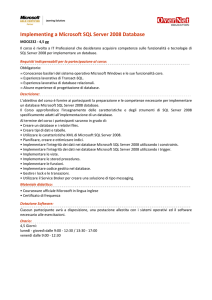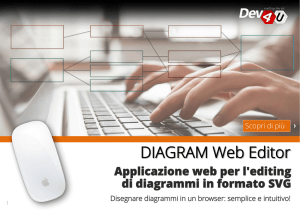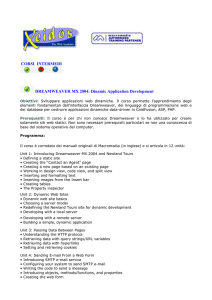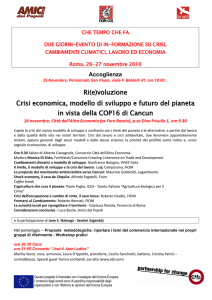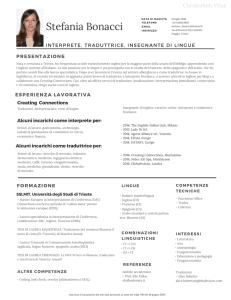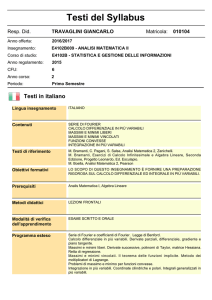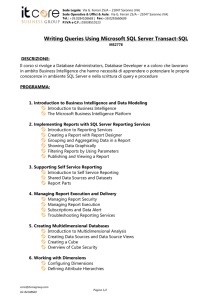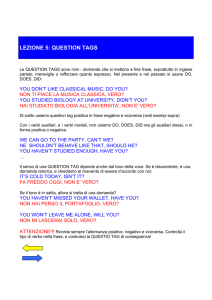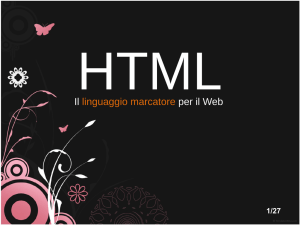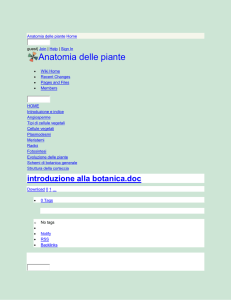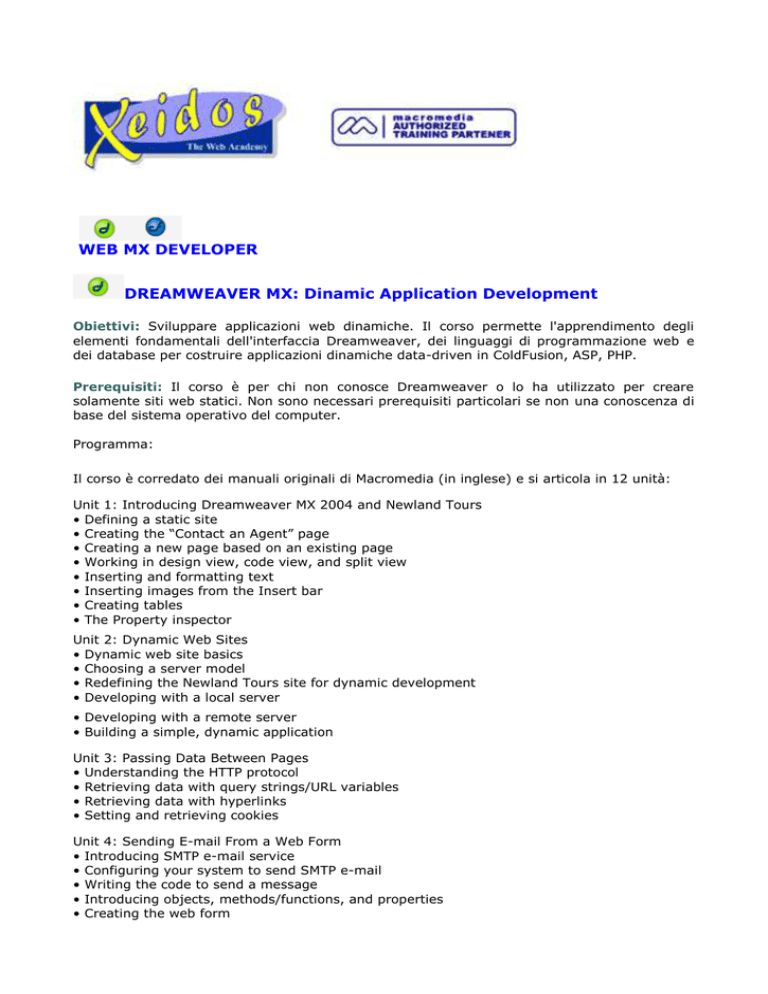
WEB MX DEVELOPER
DREAMWEAVER MX: Dinamic Application Development
Obiettivi: Sviluppare applicazioni web dinamiche. Il corso permette l'apprendimento degli
elementi fondamentali dell'interfaccia Dreamweaver, dei linguaggi di programmazione web e
dei database per costruire applicazioni dinamiche data-driven in ColdFusion, ASP, PHP.
Prerequisiti: Il corso è per chi non conosce Dreamweaver o lo ha utilizzato per creare
solamente siti web statici. Non sono necessari prerequisiti particolari se non una conoscenza di
base del sistema operativo del computer.
Programma:
Il corso è corredato dei manuali originali di Macromedia (in inglese) e si articola in 12 unità:
Unit 1: Introducing Dreamweaver MX 2004 and Newland Tours
• Defining a static site
• Creating the “Contact an Agent” page
• Creating a new page based on an existing page
• Working in design view, code view, and split view
• Inserting and formatting text
• Inserting images from the Insert bar
• Creating tables
• The Property inspector
Unit 2: Dynamic Web Sites
• Dynamic web site basics
• Choosing a server model
• Redefining the Newland Tours site for dynamic development
• Developing with a local server
• Developing with a remote server
• Building a simple, dynamic application
Unit 3: Passing Data Between Pages
• Understanding the HTTP protocol
• Retrieving data with query strings/URL variables
• Retrieving data with hyperlinks
• Setting and retrieving cookies
Unit 4: Sending E-mail From a Web Form
• Introducing SMTP e-mail service
• Configuring your system to send SMTP e-mail
• Writing the code to send a message
• Introducing objects, methods/functions, and properties
• Creating the web form
• E-mailing dynamic form values
• Client-side form validation
Unit 5: Building a Tour Price Calculator
• Creating the pages
• Building the form
• Collecting, processing, and displaying the data
• Adding server-side form validation
• Creating the conditional region
• Creating and applying a custom CSS class
Unit 6: Databases on the Web
• A crash course on databases
• Touring the Newland database
• Connecting the site to a database
• Creating recordsets and displaying database information
Unit 7: Completing the Price Calculator
• Dynamically populated drop-down menus
• Creating filtered recordsets
• Revising the calculation script with live data
• Documenting your code with comments
Unit 8: Filtering and Displaying Data
• Preparing the input page
• Generating URLs dynamically
• Preparing the output page
• Populating page layouts dynamically
• Adding dynamic images and formatting the population number
• Looking up foreign table data with SQL
Unit 9: Building the Tour Descriptions
• Planning the application
• Creating recordsets with joins
• Building the descriptions
• Inserting images and alt attributes
• Implementing recordset paging
• Passing data to other applications
Unit 10: Building Search Interfaces
• Preparing the search page and creating the Search All link
• Searching by region: building the interfaces
•
•
•
•
Commenting code for testing and debugging
Suppressing the navigation bar conditionally
Searching by country: filtering by form variable
Switching SQL statements according to environmental variables
Unit 11: Authenticating Users
• User authentication as a web application
• Building the registration pages
• Building the log-in page
• Creating an Application.cfm (CF only)
• Enabling sessions in PHP
• Restricting access to pages
Unit 12: Managing Content with Forms
• Creating the admin section
• Two approaches to formatting content stored in a database
• Creating the form interface
• Using session variables and hidden fields to track users
• Inserting the record
Unit 13: Building Update Pages
• Preparing the pages
• Planning master-detail pages
• Making the detail page updateable
FAST TRACK TO COLDFUSION MX
Corso Intermedio propedeutico alla certificazione Macromedia "ColdFusion MX
Developer"
Obiettivi: Al termine del corso sarete in grado di:
- configurare e gestire l'ambiente di sviluppo di ColdFusion MX
- usare il linguaggio Markup di ColdFusion (CFML)
- collegarsi a un database
- costruire query in grado di recuperare, inserire e aggiornare i dati dinamicamente
- controllare in sicurezza l'accesso alle pagine da parte dei visitatori
- usare parti variabili (URL, form, query, ...)
- incorporare nella vostra applicazione tags personali, funzioni definite dall'utente e
componenti di ColdFusion
- creare un form di ricerca
- sviluppare applicazioni web guidate da database interamente interattive
Prerequisiti: - familiarità con la terminologia web
- comprensione delle caratteristiche di un web server
- esperienza con i tag e la sintassi html
- familiarità con i comandi SQL, in particolare SELECT; INSERT; UPDATE; DELETE
Programma:
-
elementi di base: i vantaggi delle pagine dinamiche, il linguaggio CFML, caratteristiche e
componenti di ColdFusion MX
- le principali funzioni di ColdFusion, l'uso delle varaiabili e delle funzioni
- come pubblicare il contenuto di un database
- come riutilizzare i templates
- costruire form con ColdFusion
- costruire interfacce di ricerca
- costruire una interfaccia Data-Drill
- inserire nuovi dati
- aggiornare i dati
- mantenere lo stato di una sessione di lavoro
ADVANCED COLDFUSION MX DEVELOPMENT
Corso Avanzato
Developer"
propedeutico
alla
certificazione
Macromedia
"ColdFusion
Mx
Obiettivi: Corso Avanzato propedeutico alla certificazione Macromedia "ColdFusion
Mx Developer"
Prerequisiti: Sono necessari i seguenti prerequisiti:
- i contenuti del corso "Fast Track to ColdFusion MX"
- almeno tre mesi di esperienza nello sviluppo di applicazioni ColdFusion
- esperienza pratica nell'utilizzo di CFML tags, funzioni e variabili
- esperienza pratica con i comandi SQL compresi SELECT, INSERT, UPDATE
Programma:
Il corso è corredato dei manuali originali di Macromedia (in inglese) e si articola in 11 unità:
Unit 1. Introducing the Course
• About the Course
• Course Objectives
• Course Prerequisites
• Course Format
• Internet Applications: The Big Picture
• The Internet: past, present, future
• Next generation Internet applications
• The client side
• The server side
• Application architecture
• The Macromedia vision and next generation Internet applications
• Training
Unit 2. Creating Advanced Queries
•
•
•
•
•
•
•
•
•
•
•
•
•
•
•
•
•
•
•
•
•
•
•
•
•
•
•
•
The Query Object
Looping over queries
<cfloop> tag
Nesting query output tags
Toolbox: <cfdump>
Summarizing and Grouping Data
Grouping output using CFML
Usage example
Grouping Data with SQL
Aggregates
Usage example
GROUP BY
Usage example
Filtering groups In SQL
Usage example
Transaction Processing
<cftransaction>
Usage example
Query of Queries
Using dbtype
Supported SQL language features
Query Caching
Caching strategies
Query-based caching
Pros and cons
cachedwithin attribute
cachedafter attribute
Flushing cached queries
Unit 3. Manipulating Data with Structures
• Understanding Structures
• Creating Structures
• Populating structures using bracket notation
• Populating structures using dot notation
• Controlling the case of key names
• Creating structures without StructNew()
•
•
•
•
•
•
•
•
•
•
•
•
•
Displaying structure values
Manipulating Structures with Functions
Summary
StructKeyExists()
StructClear()
StructDelete()
Toolbox: Variable Naming Conventions
Looping Over Structures
Using Built-In ColdFusion Data Structures
Dynamically Evaluating Variables
Dynamic form variables example
Using structure notation
Using Evaluate()
Unit 4. Working with Lists and Arrays
• Understanding Lists
• Creating lists
• Using <cfset>
• Using forms
• Automatically by ColdFusion
• Manipulating lists with functions
• Summary
•
•
•
•
•
•
•
•
•
•
•
•
•
•
•
•
•
•
•
•
•
•
•
•
ListGetAt()
Looping over lists
Understanding Arrays
Benefits of arrays
Creating and populating arrays
Displaying array values
Properties of ColdFusion arrays
Manipulating Arrays With Functions
Summary
ArrayLen()
ArrayAppend()
ArrayDeleteAt()
Looping Over Arrays
Combining Data Structures
Displaying values from complex data structures
Array of structures
Array of arrays
Array of queries
Accessing Data by Value or Reference
Accessing data by value
Accessing data by reference
Data type access summary
Copying complex variables with Duplicate()
Comparing to StructCopy()
Unit 5. Persisting Data Across Pages
• Persistent Variables
• Variable overview
• Variable hierarchy
• Application Variables
• Enabling application variables
• ColdFusion Administrator settings
• <cfapplication> tag settings
• Creating application variables
• Flushing application variables
• Caching queries in the application scope
• Queries that rarely change
•
•
•
•
•
•
•
•
•
•
•
•
•
•
•
•
•
•
•
•
•
Queries that change but are used often by multiple users or pages
Comparing variable-based and query-based caching
Locking Shared Scope Variables
Locking case study
<cflock> syntax
Writing shared data
Reading shared data
Using named locks
Locking Guidelines
HTTP Cookie Variables
Cookie uses
Making cookies
Cookie types
Persistent cookies
Session cookies
Accessing cookies
<cflocation> and cookies
Session Variables
Enabling session variables
ColdFusion Administrator settings
<cfapplication> tag settings
•
•
•
•
•
•
•
•
•
•
•
•
•
•
•
•
•
•
•
•
•
•
•
•
•
•
•
•
•
Identifying a session
Built-in session variables
Creating session variables
Using session variables
Locking
Disabled cookies
URLSessionFormat()
Ending a Session
Summary
Using J2EE Sessions
Client Variables
Setting up client variables
ColdFusion Administrator settings
Storing client variables
Configuring a database for client variable storage
Enabling client variables in a <cfapplication> tag
Identifying a client
Built in client variables
Creating client variables
Using client variables
Disabled cookies
Client variable functions
DeleteClientVariable()
GetClientVariableList()
Toolbox: WDDX
Serialization
Deserialization
Implementing WDDX
Usage example
Unit 6. Building User-Defined Functions
• Introducing User-Defined Functions
• Benefits
• Creating a simple UDF
• Creating User-Defined Functions
• Function syntax
• <cffunction>
•
•
•
•
•
•
•
•
•
•
•
<cfargument>
<cfreturn>
Using Variables in Functions
Using the var keyword
Usage example
Creating queries in UDFs
Passing Arguments to UDFs
Unnamed, positional arguments
Named arguments
Passing arguments by value or reference
Storing UDFs
Unit 7. Structuring Applications with ColdFusion Components
• Encapsulating Code
• Introducing ColdFusion components
• Benefits
• Creating a Static Component
• Example
• Using CFC Self-Generating Documentation
• Browsing a CFC directly
• Obtaining argument and return information
•
•
•
•
•
•
•
•
•
•
•
•
•
•
•
•
•
•
•
•
•
•
•
•
•
•
•
•
•
•
•
•
Obtaining more descriptive information
<cfcomponent>
<cffunction>
<cfargument>
Viewing CFC details in Dreamweaver MX
Component details
Method details
Invoking CFC Methods
Example CFC
Using <cfinvoke>
<cfinvoke> attributes
Using packages
Passing arguments to a method
Inline in the <cfinvoke> tag
Using the <cfinvokeargument> tag
Using <cfobject> with <cfinvoke>
Instantiating the component
Invoking methods of the component instance
Using <cfobject> with object dot notation
Instance-Based Components
Benefits of instance-based components
Encapsulating a shopping cart
Creating Instance-Based Components
The this scope
Initializing CFC properties
Referencing CFC properties
Self-documentation of CFC properties
<cfproperty>
Persisting CFC Instances
Example
Tips
Locking
Unit 8. Reusing Code with Custom Tags
• Understanding Custom Tags
• CFML custom tags
• Custom tag elements
• Comments
•
•
•
•
•
•
•
•
•
•
•
•
•
•
•
•
•
•
•
•
Custom Tag Attributes
Passing attributes as name/value pairs
Referencing attributes
Requiring attributes
Toolbox: <cfexit>
Using optional attributes
Setting Results on the Calling Page
The caller scope
Avoiding overwriting calling page variables
Calling Custom Tags
Custom tag locations
Using <cf_> syntax
<cf_> syntax
<cfmodule>
Name attribute
Template attribute
Toolbox: Graphing Data With <cfchart>
Types of graphs
Basic syntax
<cfchart> tag
•
•
•
•
•
•
•
•
•
•
Creating charts from queries
Creating charts from individual data points
Combining query and data points
Creating multiple plots on one chart
Administering charts
More chart capabilities
(Optional) Using Custom Tags With End Tags
Custom tag instance data
Processing modes
Example of a custom tag with start and end tags
Unit 9. Handling Errors
• Introducing Error Handling
• ColdFusion error handling
• Customizing Error Message Per Application
• <cferror>
• Error types
• <cferror> syntax
• Error template
• <cferror type="request"> error variables
• <cferror type="validation"> error variables
• Understanding the Try/Catch Methodology
• Implementing the try/catch methodology
• <cftry>
• <cfcatch>
• Usage example
• <cfcatch> exception types
• <cfcatch> variables
• Variables common to all <cfcatch> exception types
• Usage example
• <cfcatch> exception type-specific variables
• Error Handling Strategies
Unit 10. Searching with Verity
• Searching Documents Using Verity
• Creating a collection
• Indexing a document collection
• Finding the matching documents
•
•
•
•
•
•
•
•
•
•
Creating a search page
Toolbox: Self-Posting Forms
Searching Database Content Using Verity
Creating a collection
Indexing a database collection
Creating a search page
Finding and displaying the matching records
Displaying the details of the record selected
Differences between document and database searching
Beyond the basics
Unit 11. Exchanging Data Over the Internet
• Exchanging Data Over the Internet
• Introducing <cfhttp>
• Syntax
• <cfhttp> return variables
• Get versus post methods
• Retrieving Text with <cfhttp>
• Get method
• Post method
• Passing parameters with <cfhttpparam>
• Example
• Handling <cfhttp> Exceptions
• Retrieving WDDX Packets with <cfhttp>
• Process
• Example
• Using parameterized WDDX packets
• Introducing XML
• Comparing WDDX and XML
• XML document
• XML document object
• Creating XML Documents
• Using <cfxml> to create an XML document object
• From static text
• From dynamic data
• Using XMLFormat()
• Using ToString() to convert an XML object into an XML document
• Retrieving XML Data from XML Documents
• Retrieving an XML document
• Using XMLParse() to convert an XML document into an XML object
• Retrieving data from an XML document object
• XML Document object
• Accessing specific elements
• Looping over elements
• Using XMLSearch() to search for specific elements in an XML object
• Using Web Services
• How web services work
• Publishing web services
• WSDL files
• Viewing a WSDL in a browser
• Message elements
• Distributor GetDist service example
• Distributor InsertDist service example
• Viewing a WSDL in Dreamweaver MX
• Registering WSDL files in the ColdFusion Administrator
• Consuming Web Services
• Using <cfinvoke>
• Specifying security information
• Consuming ColdFusion Web Services with Macromedia Flash MX
• Flash Remoting
• Training

